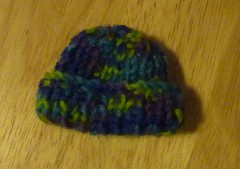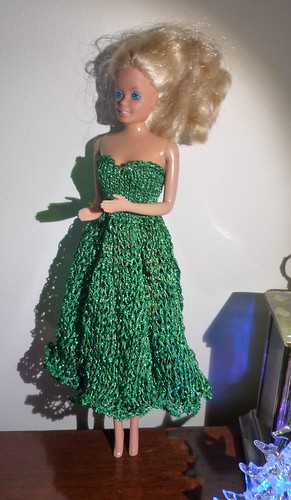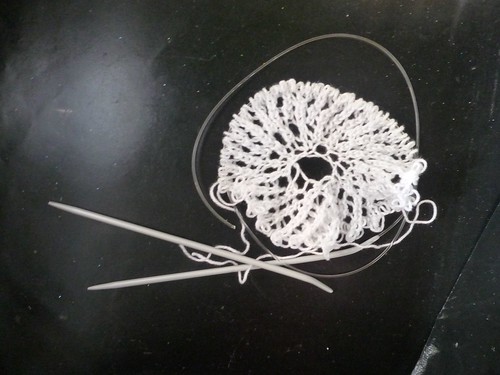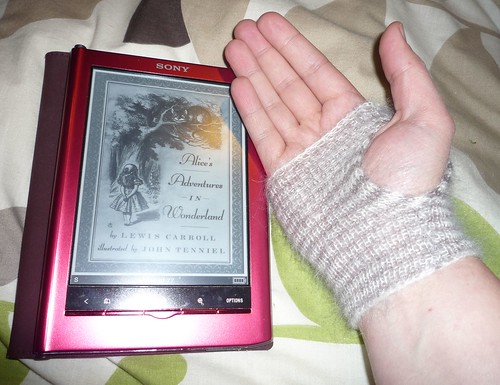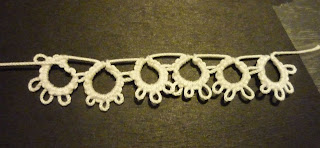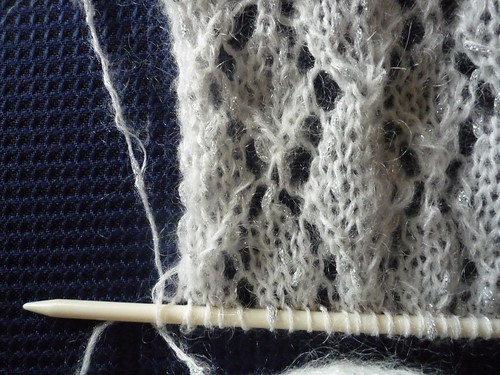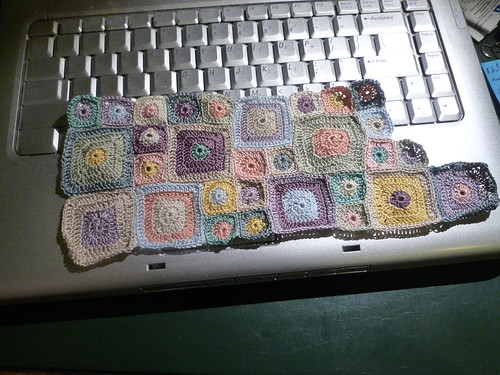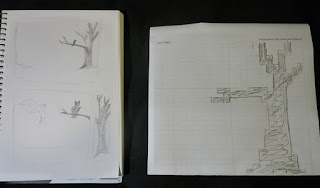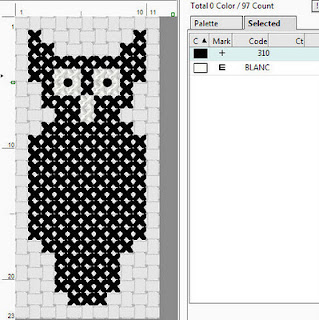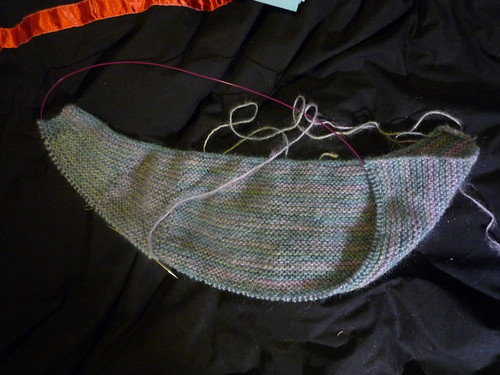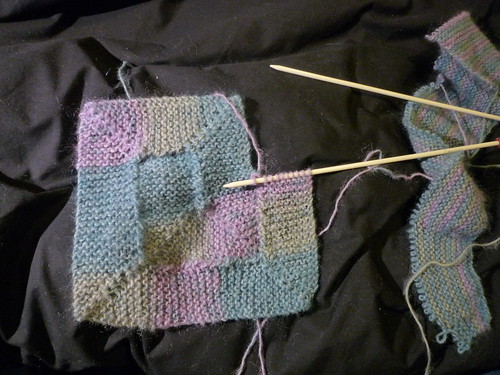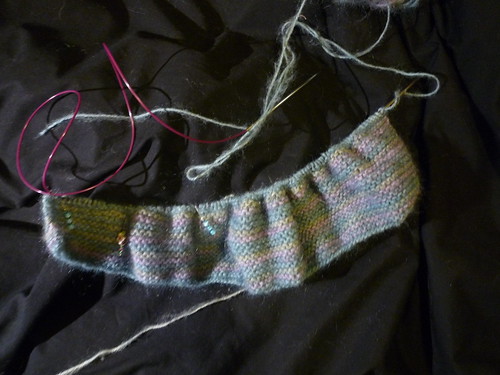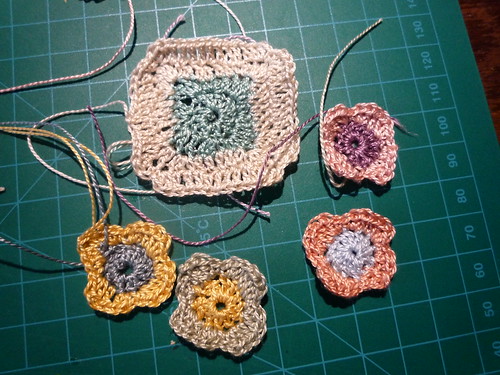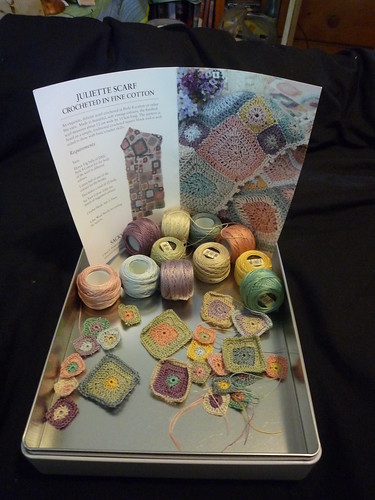This is a variation of a lovely bag The Anticraft's online 'zine. It is called
Creeping Jenny and I really loved the innovative design. It uses a piece of vinyl with holes punched around the edge which the yarn is then picked up through and knitted. The pattern also uses an interesting contrast of black and a bright green that I love.
The materials I used (due to the difficulty finding supplies sometimes, I had to make a few subsitutions).
- 1 piece of leather, 16 cm in diameter
- Smallest leather punch you can find (mine is about 2-2.5 mm in diameter)
- 1 skein each of '2nd Time Cotton', one charcoal (922) and one avocado (549)
- 4.5 mm circular knitting needle
- Stitch markers
I was going to make this as written (well, more or less). I found a bit of leather (old scrap from my Mum's craft stash) that I cut to shape and punched holes in. The
Creeping Jenny pattern calls for 100 holes around the edge of the 16 cm diameter, or about one 2 mm hole every 5 mm. But I was worried that this would actually end up weakening the base- think of the perforations on stamps to make them easy to tear apart! So instead I only made half the number of holes.
 |
| Sticky tape is a great way to hold your template in place while you make the holes |
 |
| I only punched every other hole because I didn't want to have a weak join |
To cast on from your base you need a small crochet hook that will fit through the holes of the base. From the right side, push your crochet hook through the hole and use this to pull a loop of wool to the right side. Place this onto a circular knitting needle.Repeat until you have 50 stitches on your needle.
In the first round, knit in the front and back of loop to double the number of stitches. Knit the next four rounds to make the base.
Originally I intended to make the
Creeping Jenny pattern- sort of a yin-yang feel pattern. But then I started to think. I liked the pattern, but it wasn't quite right. What I wanted was similar but more like.... a maze... like a labyrinth! Ooooh.... I saw a lovely example a month or so ago on
Craftster using tunisian crochet. The colours of this are lovely (the only thing that prevented me from changing my colours was the fact I'd already bought my yarn!). I could've used this pattern but since I'm knitting in the round, I thought it would be nice to have a maze that went all the way around.
To google I went! Only to find that there were was no such thing out in internet land- d'oh! There is only one thing to do- make one myself. Step one was to make a maze. Now here I did cheat a bit. In my internet searching I found this terrific
maze generator. It lets you pick the size and dimensions of the maze that you wish to make, along with an option of 'average path length' or 'how far on average before reaching a turn'. It then makes both a review black and white image of the maze (to get a feel for how it will look as a pattern) along with a graph version. Because the size will include a border around the edge, I generated a 101 wide by 39 high maze with an average path length of 3.
 |
Half way point when I realised the bag would
be too big with the chart as written! |
The resulting graph was lovely and twisty but that border needed sorting out. So the next step, copy the graph into my go-to cross stitch program. I did this by hand because the jpg of the maze generated had a watermark that I thought might confuse the pattern import. Once that was done, I tweaked the design to make a seamless graph by removing the border and making some paths over the border and fixing a few bits for technical issues. While I don't mind a 10-15 stitch float because I know I am going to line the resulting bag, I thought a 35 stitch float might be a bit long! I actually have two different graphs, one of 40 charted rows, the other of 30. This is due to me reaching the halfway point in my knitting and realising that my bag was going to be VERY deep if I followed the original pattern so I went back to my pattern and fiddled it a bit to make a shorter version. Click on the chart to embiggen.


Now if you want to make this yourself, I would recommend two things- lots of stitch markers (I'm using one every ten stitches) and printing out the graph so you can cross off as you go. I'm using the multi-pass technique described here at
TECHknitting. Basically, on the first pass of a row, you knit all the stitches of one colour (eg green) and slip (purlwise to prevent stitches twisting) all the colours of the contrast colour (black). After one round you go back with the OTHER colour and knit all the black stitches and slip all the green- so after two goes around you have done ONE row of knitting. For this pattern, TWO rows of knitting are needed per charted row so that will mean four times around per charted row. Confused yet? Wait, there's more!
You also need to remember for knitting charts to start at the BOTTOM RIGHT of the chart and read from right to left. Now this is not absolutely vital for this chart. Your hero blogger managed to forget this crucial point and only realised several rows in. Not wanting to have to frog the knitting, she shrugged and called it a mirror design feature. But if you are doing a chart with letters, for instance, this important tip will prevent your letters and words being backwards.

The other important thing to be aware of is the yarn that is carried behind the knitting on the slipped stitches called floats. In this pattern they are often very long in places- this is not recommended practise for clothing! If this were a jumper or gloves your hands would get tangled in them constantly, they'd break and things would turn ugly very quickly. There are ways to deal with this- there are techniques to fix them on long stretches (every 3-4 stitches is recommended in my reading) or they can be sewn into place after. I'm not too worried in this project however as this is a bag and I intend to line it with material anyway to prevent things like pencils or knitting needles from poking out the side. Just make sure to leave enough slack in the float so bag is not so tiny so as to be suitable for carrying only long skinny knitting needles!
Keep going until the end of the chart. Knit one more row. To finish the bag I followed the original
Creeping Jenny instructions from the eyelet row to the end.
Here's the results before blocking. I'm hoping the weather will be nice tomorrow so I can block this baby and finish it off including a lining and eyelets. See
here for how I made a lining for the bag.
 |
| This side shows the middle of the pattern |
 |
| This side shows the two ends of the pattern. If you look very closely you may be able to see the slight stager from going from one round to the next. However the difference is slight and should disappear with some careful blocking. |
If you use the chart to make a bag or something else then please let me know! I'd love to see what it looks like in different colours. Feel free to use this chart and any other on this blog for your own purposes, just don't sell them.

